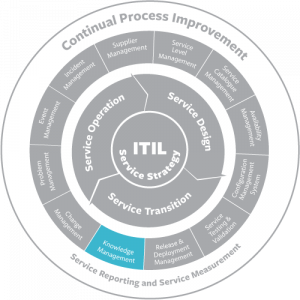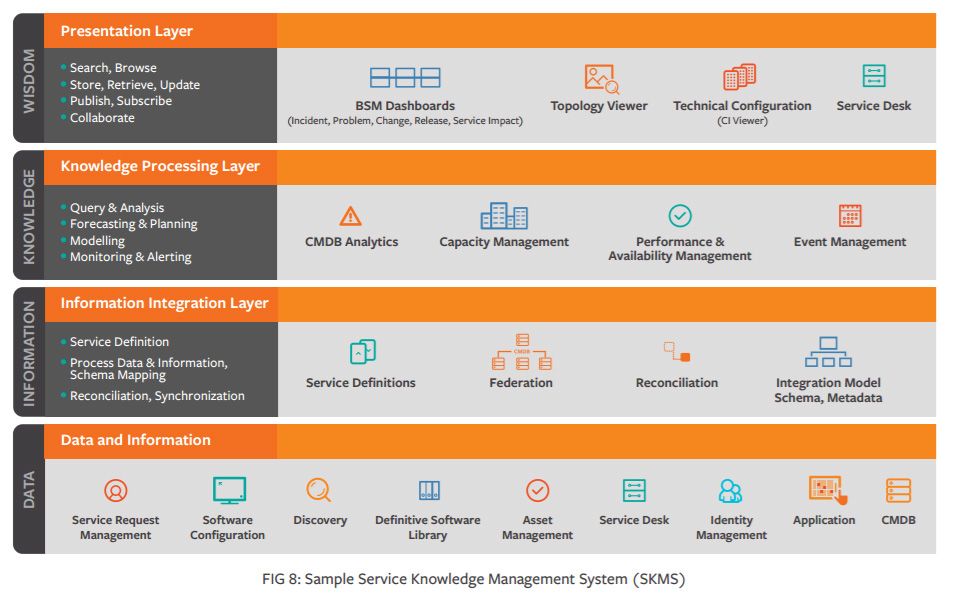What is ITIL knowledge management?
Knowledge management is responsible for maintaining the service knowledge management system (SKMS), which represents the total body of knowledge within the service management organization.

In order to deliver service successfully, it is necessary that knowledge be captured, organized, and made available to all with a need to know. The SKMS contains all of the other data stores used by service management, including:
- Service portfolio
- CMS
- Supplier and contract management information system (SCMIS)
- Availability, capacity, and security management information systems (CMIS, AMIS, and ISMIS)
- CSI register
Download Now: ITIL 4 Best Practice e-Books
These all-new for 2020 ITIL e-books highlight important elements of ITIL 4 best practices. Quickly understand key changes and actionable concepts, written by ITIL 4 contributors.
Knowledge can be categorized according to the data-information-knowledge-wisdom (DIKW) structure as follows:
- Data (often called “raw data”) represents discrete facts or numbers. By themselves, data items have little meaning. The responsibility of knowledge management with respect to data is to capture data, identify relevant data, maintain its integrity, and archive or purge data when it is no longer needed.
- Information is generated when data is viewed in context. This typically involves the use of statistics such as averages or peak and minimum values. The responsibility of knowledge management with respect to information is to manage content in a way that allows users to query and analyze it.
- Knowledge combines information with experience. Knowledge can be used as a basis for decision-making or taking an action. The responsibility of knowledge management with respect to knowledge is to support the tools that allow users to spot trends, or determine that a threshold has been exceeded.
- Wisdom can be created by taking advantage of all the knowledge available, such as recognizing that a recent deterioration of service performance coincided with the adoption of a new procedure. The responsibility of knowledge management with respect to wisdom is to make available the tools needed to identify these associations.
As you manage your IT team, you want to be sure that every employee has access to accurate and reliable information. Knowledge is key when it comes to successfully completing tasks and ensuring that your team can provide effective services, so how do you manage the flow of information in an IT team? Information Technology Infrastructure Library (ITIL) knowledge management helps keep team members informed, knowledgeable, and ready to assist customers.
Service knowledge management system example

ITIL knowledge management defined
ITIL knowledge management is aimed at helping you and your team make decisions throughout the service process by controlling and managing the flow of information. When you use knowledge management, you are able to ensure that the knowledge that is being distributed to employees is accurate, reliable, and trustworthy. Improving the quality of information prepares employees to make effective decisions, and the end result is a more efficient team.
The benefits of knowledge management
By implementing knowledge management practices in the workplace, IT managers can improve their teams and provide better service. Consider these benefits:
- Decreases the amount of time that must be spent on training employees. Since your team will constantly receive accurate and up-to-date information, they will require fewer formal training sessions to continue to meet and exceed performance expectations.
- Reduces the number of errors that are made by team members. If your team has the knowledge that they need to make decisions, they are far less likely to make mistakes.
- Reduces the need to complete steps in the service process more than once. When everyone is informed about the process, it is less likely that a step will be performed incorrectly. By implementing knowledge management, you give your team the power to reduce service process time by eliminating the need to repeat steps.
- Allows IT professionals to respond to customer needs faster and more effectively. Your employees will know how to answer customer questions more often, so you will not have to intervene or respond to negative feedback about team members’ lack of knowledge.
The stages of knowledge management
As with other ITIL concepts, knowledge management must be understood before it can be implemented. There are four stages of knowledge management.
Data
Raw data consists of the facts that are available in databases that you and your IT team use on a daily basis. When this data is processed, it becomes information that can be distributed to team members.
Information
Once the raw data has been given context, it becomes information. To create information, the data is sorted according to type. In other words, it answers “who, what, where, when, and why” questions. The translated information can then be relayed via documents, email, and formal reports to establish relevant information.
Knowledge
When you and your team members analyze information while taking your own experiences into consideration, knowledge is formed. Your insights into the information that is translated from raw data turn basic information into real knowledge. Once the facts have reached this stage, you can start to use knowledge to make decisions.
Wisdom
When you have knowledge, you will use these facts to put them into context in IT service situations. You and your team are responsible for using personal judgment, experience, and expertise to properly apply knowledge in a way that allows it to reach the wisdom stage of knowledge management.
Knowledge management activities
The process of knowledge management is also broken down into key activities that must be performed to complete the process.
Knowledge Management Strategy
As an IT manager, you need to create a strategy for identifying the information that should be processed through knowledge management. Many organizations identify feedback from customers, repeated incident reports, and the costs associated with providing and managing support systems as key data that needs to be translated into facts to be distributed across the team. Your strategy should determine the types of information to target for processing through knowledge management. You’ll need to document your strategy to ensure that everyone on the team understands what is expected.
Knowledge Transfer
Once you have your strategy in place, you will have to decide how knowledge will be transferred among team members and between departments. The first step in knowledge transfer is determining where gaps are located to ensure that you have a plan for getting knowledge to the appropriate people in the organization. By taking the time to identify gaps, you can eliminate them. It is helpful to create a communication plan for disseminating information across channels during this activity.
Information Management
Information can only become knowledge if it is properly managed and distributed across your team. Access to information is essential to the knowledge management process. Information management is part of the process that involves gathering data, managing information, and determining how this information will be translated to become knowledge. Policies and procedures can be created using information, but you must first establish a process to organize this information into a procedure and record it in a manual your team members can access as needed.
SKMS
The Service Knowledge Management System (SKMS) is a group of systems, tools, and databases required for successful knowledge management. As an IT manager, you will use the system to store, update, and manage data on a regular basis. Team members can access information through the system at any time of the day, so utilizing such a system is of the utmost importance for teams that include members across time zones.
There are two key portions of the SKMS:
- The Configuration Management System (CMS) manages all configuration information that is entered into the system. Incident reports, established errors, and feedback are all part of this system.
- Configuration Management Databases (CMDBs) contain key pieces of configuration data that have been entered into the database.
- The Service Knowledge Management System also contains several layers that allow information to be processed as knowledge and made available to team members and other people in the organization through tools and databases. There are four layers:
- The Presentation Layer allows users to access information. In this layer, users are presented with visual materials that allow them to search, browse, and update information they find in the system. Users may also be given the opportunity to collaborate to improve the knowledge base and ensure that edits are made as needed.
- The Knowledge Processing Layer allows users to report information that can be analyzed. Performance management is also a part of this layer and can be used to determine whether your team members are meeting performance goals. You can monitor scorecards in this layer to help improve the productivity of your team.
- The Information Integration Layer integrates all of the information from relevant portions of the organization in one place. If your organization has partners, information related to these partners may also be found in this layer.
- The Data Integration Layer integrates the data that must be managed for a successful Knowledge Management process by managing applications, documents, and files. The data sources are found in this layer, as well as the tools team members can use to properly apply data as knowledge.
Who uses knowledge management?
In one form or another, knowledge management is used by everyone in your organization. Your job as an IT manager is to ensure that data is properly processed into information,which is stored in a location that is accessible to the people who require specific knowledge to successfully complete job tasks. Your team will run more efficiently if you use knowledge management properly.
At your team’s level, knowledge management creates knowledge and access to this knowledge when necessary. All of your team members will be responsible for identifying the need to translate information into knowledge, while you will need to manage the databases and manuals that are available to your team members.
Outside of your IT team, knowledge needs to be available to users through self-service portals. To improve the efficiency of your team, basic knowledge should be available to users who are willing to troubleshoot their own problems. When users can find solutions on their own, your team has opportunity to focus on escalated issues that require special skills and knowledge that is not available to those who are not familiar with IT applications, processes, and knowledge.
Keys to knowledge management success
If you are just starting to implement knowledge management in your organization, it may be difficult to get everyone else on board with the idea. While knowledge management is a significant undertaking, it is one that yields tangible benefits. To ensure that your efforts are successful, you need to involve everyone affected by the changes. You will also need to establish methods to manage the problems that may arise.
Involving Members of the Organization
Unless you own your own business or are working in a small or mid-sized company, you will probably need to find someone at the executive level to advocate for implementing knowledge management. To ensure that you have a strong advocate, take the time to explain the benefits of knowledge management to high-level managers. Not only will a high-level manager be able to gain approval for your plan, but involving such a professional will give you the benefit of in-house support throughout the process.
To get everyone on the same page, you will need to proactively educate them about the reasons for implementing knowledge management. Be sure to explain how implementation will help improve customer service and allow people to find solutions for their issues on their own when the incidents do not have to be reported and processed.
As you implement knowledge management, be sure to monitor progress to report to associated members of the organization. Gaining support for knowledge management is often a matter of showing that the process creates a positive outcome.
Being Proactive about Managing Problems
Knowledge management is partially about successfully managing problems that your IT team may encounter. These problems may even be related to the knowledge management process itself. To avoid delays in implementation and efforts to update knowledge databases, it is important for you to establish roles and dictate how problems will be resolved before implementation.
The most essential part of avoiding problems with knowledge management is to both assign roles and assure that team members understand their roles. If everyone knows the part that they play in the knowledge management process, your team will be better able to collaborate.
The Relationship between knowledge management and other processes
Knowledge management affects all processes that your IT team encounters. When you and your team members collaborate to establish procedures, these procedures are then used to handle everything from incident reporting to managing databases. Managing knowledge for your IT team allows other processes to flow smoothly by ensuring that there are established procedures available for your team members to follow.
Conclusion
Your IT team can be more efficient and effective when everyone on the team collaborates to create knowledge resources. ITIL knowledge management offers a guideline for recording data, processing information, and creating a knowledge database that can be accessed by your team members as needed. The end result is a more knowledgeable and effective team that can promptly process incident reports to provide superior customer service.








